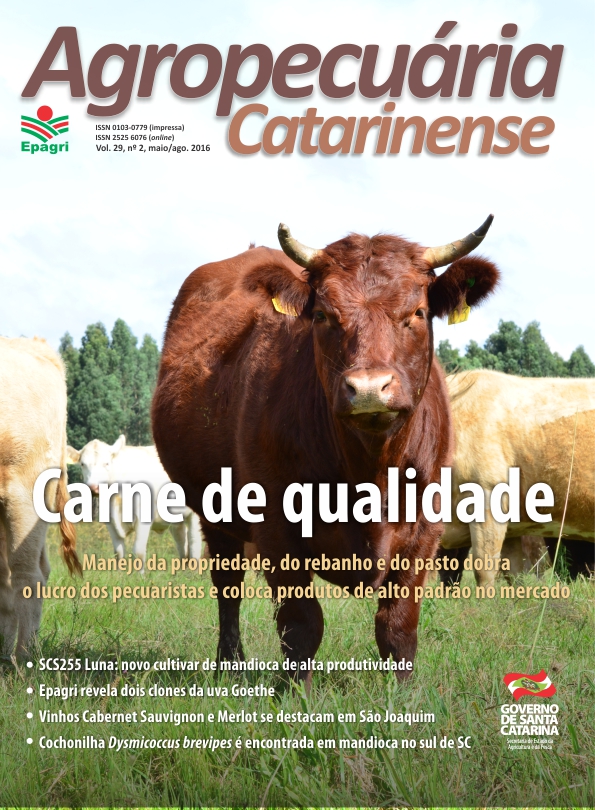Occurrence of Dysmicoccus brevipes in cassava roots in Santa Catarina State and reproductive changes related to the rearing substrate
DOI:
https://doi.org/10.52945/rac.v29i2.59Keywords:
Cochonilha-da-raiz, Pseudococcidae, Manihot esculentaAbstract
Abstract: Mealybug field samplings were performed on cassava (Manihot esculenta, Crantz) roots aiming to start a stock culture in laboratory. Field collections were carried out during seasons 2010/11 and 2011/12 in Santa Catarina State, Brazil. Rearing of mealybugs were established on Cassava roots and ‘Cabotiá’ pumpkin, which showed mating and thelytokous parthenogenesis on these hosts, respectively. Mealybugs were identified as Dysmicoccus brevipes (Cockerell, 1893). This work recorded the first occurrence of this specie attacking cassava roots in Santa Catarina State.Metrics
Publication Facts
Reviewer profiles N/A
Author statements
- Academic society
- Epagri - Revista Agropecuária Catarinense
- Publisher
- Empresa de Pesquisa Agropecuária e Extensão Rural de Santa Catarina - Epagri
References
BERTIN, A.; BORTOLI, L.C.; BOTTON, M.; PARRA, J.R.P. Host Plant Effects on the Development, Survival, and Reproduction of Dysmicoccus brevipes (Hemiptera: Pseudococcidae) on Grapevines.
Annals of the Entomological Society of America, v.106, n.5, p.604-609. 20
CABI. 2015. Dysmicoccus brevipes (pineapple mealybug). Disponível em: <http://www.cabi.org/isc/datasheet/20248>. Acesso em: 30 nov. 2015.
GARCÍA, M.; DENNO, B.; MILLER, D.R.; et al. ScaleNet: A literature-based model of scale insect biology and systematics. Disponível em: <http://scalenet.info>. Acesso em: 4 dez. 2015.
GRANARA DE WILLINK, M.C. Conociendo nuestra fauna. I. Superfamilia Coccoidea (Homoptera: Sternorrhyncha). San Miguel de Tucumán, Facultad de Ciencias Naturales e Instituto Miguel Lillo (Serie Monográfica y Didáctica nº 6). 1990, 43p.
IBGE. Instituto Brasileiro de Geografia e Estatística. Indicadores IBGE – Estatística da Produção Agrícola, mar. 2013, 79p.
LACERDA, J.T.; CARVALHO, R.A.; OLIVEIRA, E.F. Cochonilha Dysmicoccus brevipes: a praga cosmopolita da abacaxicultura. Tecnologia & Ciência Agropecuária, João Pessoa, v.3, n.2, p.15-21, junho 2009.
OLIVEIRA, C.M.; FRIZZAS, M.R.; FIALHO, J.F.; GULLAN, P.J. Biology of Protortonia navesi (Hemiptera: Monophlebidae), a new cassava pest in Brazil, with notes on its behavior in the field. Annals of the Entomological Society of America, v.101, n.4, p.779-785, 2008.
PEGORARO, R.A.; STUKER, H. Abundância de Pseudococcus mandio Williams (Homoptera: Pseudococcidae) em lavoura de mandioca no litoral sul de Santa Catarina, Brasil. Revista Brasileira de Mandioca, Cruz das Almas, v.17, n.1/2, p.7-12, 1998.
PEREIRA, E.F.; DIPIETRO, L.G.; ODORIZZI, D.C. Desenvolvimento de metodologia de criação da cochonilha-da-raiz da mandioca Pseudococcus mandio Williams (Hemiptera: Pseudococcidae) em laboratório. In: CONGRESSO BRASILEIRO DE MANDIOCA, 14., Botucatu: ABAM, 2011.
PEREIRA, E.F.; DI PIETRO, L.G.; BACK, Á.J. Adequação de diferentes genótipos de mandioca à colonização da cochonilha-da-raiz em condições controladas. In: CONGRESSO BRASILEIRO DE MANDIOCA, 15., Botucatu: ABAM. p.493-497. 2013.
PIETROWSKI, V.; RINGENBERG, R.; RHEINHEIMER, A.R. et al. Insetos-praga da cultura da mandioca na região centro-sul do Brasil. (Org.) UNIOESTE – Universidade Estadual do Oeste do Paraná e Embrapa Mandioca e Fruticultura Tropical, 2010, 42p.
SANTA-CECÍLIA, L.V.C.; SOUZA, B.; SOUZA, J.C.; et al. Cochonilhas-farinhentas em cafeeiros: bioecologia, danos e métodos de controle. Belo Horizonte: Epamig, 2007. 48p. (Boletim Técnico, 79).
SCHMITT, A.T. Principais insetos pragas da mandioca e seu controle. In: CEREDA, M.P. (Coord.). Agricultura: tuberosas amiláceas latino-americanas. São Paulo: Fundação Cargill, 2002. v.2, p.350-369.
SOARES, E.A.; ITIMURA, C.R.B.; ZART, M.; DONEZE, G.S.; FELICIANO, D.C.; ALVES, V.S. Aspectos biológicos de Dysmicoccus
brevipes (Hemiptera: Pseudococcidae) em abóboras (Cucurbita maxina x Cucurbita moschata) variedade ‘Cabotiá’. In: CONGRESSO BRASILEIRO DE MANDIOCA, 16., e CONGRESSO LATINO-AMERICANO E CARIBENHO DE MANDIOCA, 1., Botucatu: ABAM. 2015.
WILLIAMS, D.J.; GRANARA DE WILLINK, M.C. Mealybugs of Central and South America. Wallingford, UK: CAB International, 1992, 635p.
Downloads
Published
How to Cite
Issue
Section
License
Copyright (c) 2016 Revista Agropecuária Catarinense

This work is licensed under a Creative Commons Attribution 4.0 International License.




